Using Herbal Powders to Supplement a Healthy Diet: An Alternative to the Daily Multivitamin
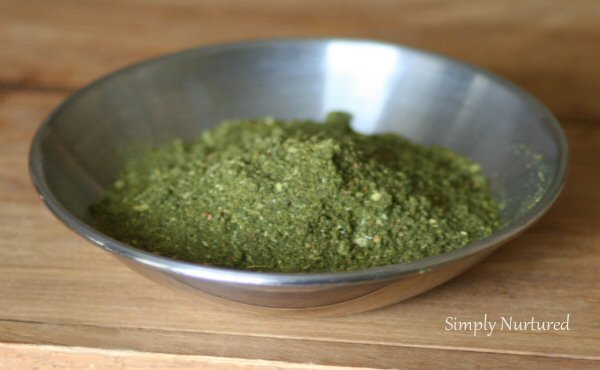
Written by Courtney, Contributing Writer
The foods we consume and the lifestyle we live form the foundation of our health. The nutrients in the foods we eat are the building blocks for all of the biological activity within the various systems of our bodies. Disease occurs when our bodies lack the nutrients necessary to perform these functions properly.
This can be due to a poor diet, an inactive lifestyle, harmful chemicals we inhale or absorb through our skin, or undue stress from a reliance on our own strength to get through the day to day instead of finding our strength in the Lord.
There are a multitude of vitamins and supplements to help support our hurried lifestyles and sometimes less-than-ideal food choices. Walk into any grocery or discount store and you can become overwhelmed with the supplements available to you.
Are Supplements Necessary?
Over the years, I’ve wrestled with the idea of using vitamins and minerals to supplement my family’s diet. I have mixed feelings about supplements.
Ideally, I believe we should obtain vitamins and minerals through the diet, just like we do the macronutrients protein, fats, carbohydrates. When we select nutrient-dense nourishing foods, the nutrients obtained from them are in their natural state in the proper ratios and are easily absorbed and utilized most effectively within the body. Supplements can contain imbalanced ratios or poor quality nutirents that pass through the body without being absorbed and used. This is certainly the case with synthetically-formulated supermarket vitamins.
Now, on the other hand, we can’t deny the fact that the soil we tend today is inferior to that which our ancestors once enjoyed. Our current agricultural system has stripped the soil of the majority of nutrients necessary for strong, healthy plant growth. As a result, plants cannot withstand disease and pests and thus need to be doused with strong chemical fertilizers to grow in the first place and pesticides to stay alive.
Our conventional fruits, vegetables, and grains are anything but thriving. Because the health of the soil is critical for plant health, today’s grains and produce contain a fraction of the nutrients they once did. Organic produce is healthier, but no doubt still affected by conventional farming methods.
For this reason, it may be wise to include supplements in our diet. Which ones and how much are tricky questions, though, and should be based on a variety of factors, taking into consideration things like the availability of local seasonal foods as well as past and current health history.
With the exception of cod liver oil, my family doesn’t take vitamins or other supplements on a regular basis. We will sometimes take muilti-vitamins and occasionally specific vitamins or minerals to treat a specific illness or when a deficiency is suspected. I typically take a multi-vitamin throughout most of my pregnancies and during most of the first year or so while breastfeeding, just for that peace of mind. I will sometimes keep a supply of chidlren’s multivitamins on hand for stretches of reduced appetites or to boost little immune systems during periods when illness abounds during the winter months. Honestly, though, my biggest concern during those winter months is a lack of vitman D, which we do get through the cod liver oil.
I understand the dangers and pitfalls of vitamin supplements, namely the tendency to eat more carelessly while on them and the incredible spectrum of quality among the different types and brands out there. I’m careful to not rely on them, but instead to use them wisely and sparingly only as needed. We seek to meet the majority of our nutritional needs through food. Thoughtfully selecting nutritious foods and preparing nourishing meals is a priority and something I take much joy in as a mother.
A Homemade Herbal Mixture to Supplement a Healthy Diet
I’ve learned that herbs can be an excellent way to support a healthy diet and over time, I’ve come to rely on herbal preparations where I once counted on vitamin pills. Many whole food-based vitamins do contain concentrated foods and herbs to supply vital nutrients, and this is ideal when selecting a good vitamin source.
I’m not saying all vitamins are bad or that you should stop taking them. We still take vitamins from time to time, especially to treat illnesses since we don’t rely on conventional medicine. But for the most part, I like to use herbal powder mixes in place of the packaged vitamin for a number of reasons.
- Nutrients straight from whole foods/herbs are more bioavailable, meaning they are best absorbed because they are in their natural form along with the proper ratio of complimentary vitamins and minerals that aid in their absorption.
- Concentrated herbal powders contain more than just vitamins and minerals. Phytochemicals in the forms of cartenoids and flavonoids, for instance, are present in dried herbs, but not all vitamin supplements contain them. Phytochemicals are beneficial for a number reasons, probably the most important being their antioxidant properties.
- Herbal powders don’t contain any sweeteners or additives.
- I can alter my herbal powder mixes to meet specific needs during different ages or stages. (For example, during my first trimester of this pregnancy, I included ginger root powder in my herbal mixture to help improve digestion and alleviate fatigue and nausea. I’ve also included eleuthero root in the past to boost energy and help combat stress and lemon peel for extra vitamin C.)
- Herbal powder preparations are less expensive than vitamins, and when I throw together my own herbs instead of purchasing prepared herbal powders, the savings are even greater.
Wheatgrass: Wheatgrass is the highlight of this powder mix. It is a very concentrated source of a multitude of nutrients, including beneficial enzymes that make it so easily digestible. It contains all essential amino acids, making it a complete protein, and is particularly known for it’s high chlorophyll and mineral content. It is rich in B vitamins and vitamins A, C, D, E, and K. There are entire books just on wheatgrass and its benefits. Some say it nourishes and revitalizes practically every cell and every system within the body. I’m sure some of its claims are exaggerated, but I’m convinced it’s good stuff! I like to grow my own because it’s so easy and grows so quickly, but when I do, we juice it and consume it that way. For this herbal mix, I purchase wheatgrass powder from my local food co-op. I’m sure it would be simple to grow and dehydrate your own, though!
Barley Grass: A complete protein (contains all essential amino acids), barley grass also contains an abundance of vitamins and minerals, noted for its high amount of calcium and iron in particular.
Oat Straw: A good source of protein, B vitamins, vitamin A, and several minerals including calcium, magnesium, phosphorous, and iron. Oat Straw is great for a number of things, but is best known for its positive effect on the nervous system and its ability to stabilize blood sugar.
Alfalfa: Alfalfa has always been one of my favorite herbal supplements! It is a rich source of minerals due to it’s deep roots that soak up trace minerals from far beneath the soil. It is a good source of vitamins, particularly vitamin A, C, E, and K. It contains a great amount of chlorophyll and is another complete protein.
Spiriluna: A blue-green algae containing large amounts of chlorophyll (green) and phycocyanin (blue), spiriluna’s benefits are numerous. It is another excellent and complete source of protein and a good source of several essential fatty acids, it also contains a great amount of vitamins and minerals.
Kelp: Kelp is a great source of minerals. I especially appreciate kelp powder for its high amount of iodine. We use real salt, sourced from the sea and unrefined. Real salt contains iodine but not in significant amounts. Iodine is critical for many body functions, particularly metabolism and thyroid function. It is best sourced from sea food, but but for a diet lower in seafood, kelp is an excellent supplement.
Fennel Seed Powder: Fennel seeds are a good source of minerals, particularly rich in iron, and contain vitamins A, C, E, and some B vitamins, as well as other antioxidants.
Stinging Nettle: Well-known for a variety of functions within the body. It is espeically rich in iron and contains plenty of vitamin C for iron absorption. It is also high in vitamin K.
Dandelion: Where do I even begin? Dandelion is rich in B vitamins, vitamins A, C, and E and is a good source of the minerals potassium, iron, and zinc. It is a mild cleansing and detoxifying herb, but not so much so that it can’t be used safely during pregnancy and in young children. Stephanie describes the benefits of dandelions and shares her own experience harvesting and drying her own dandelions here.
Rose Hips: Probably one of the best sources of vitamin C, rose hips is also desired for it’s rich source of carotenoids, including beta-carotene, lycopene and luetin, and other antioxidants. This makes rose hips great for boosting the immune system and protecting cells from oxidative damage.
Tumeric: This is an overall fantastic herb, not to mention a tasty culinary spice! A good-quality tumeric found in a bulk herb or health food store supports many systems within the body. It is a fantastic antioxidant, contains a number of vitamins and minerals, and is also notable for how well it supports healthy metabolism.
Nutritional Yeast: Nutritional yeast contains a decent amount of fiber and protein as well as some trace minerals, namely zinc and selenium, but it is best known for its high amount of B vitamins.
;
This recipe is not perfect, but it is my attempt at ensuring my family receives an abundant supply of nutrients from natural sources.I have altered this powder mix as I discovered new herbal sources of specific nutrients to meet specific needs. As you can see, this current recipe contains an abundance of B vitamins. I sought to add more sources of B vitamins early in my current pregnancy to be sure I was getting an adequate supply and to try to help with severe exhaustion. I also wanted to ensure an adequate supply of naturally-sourced and highly absorbable iron, so that is not lacking here, either.
The Perfect Addition to Your Daily Smoothie or Fresh Juice
How do we take this herbal concoction?
My family loves smoothies! We make up a family-sized batch nearly every morning. My ten year-old daughter has taken over the task of preparing our morning smoothies because she finds so much satisfaction in creating various combinations of this nutritious treat. We sometimes call her our “Smoothie Girl” in because of her love of this task.
We simply add what we call our “super power powder” with whatever we decide to throw into the blender that day. We rarely follow recipes for smoothies. It really just depends on what we have on hand and what sounds good at the time. A typical smoothies contains about half veggies and half fruit along with either water or yogurt. We sometimes dress up our smoothies with freshly-ground flax seeds, chia seeds, coconut oil, fish oil, raw eggs, fresh parsley (or other herbs), or anything else that sounds nutritious and delicious.
Kale and spinach are our favorite go-to greens, probably the base of most of our smoothies. Other favorite smoothie veggies are beets, carrots, celery, tomatoes, garlic, cucumbers, and chard. Our favorite fruits for smoothies are bananas and berries, particularly blueberries and raspberries. Other fruits we often add are mangoes, pineapples, avocados, peaches, and pears. We try to use either seasonal or frozen fruit.
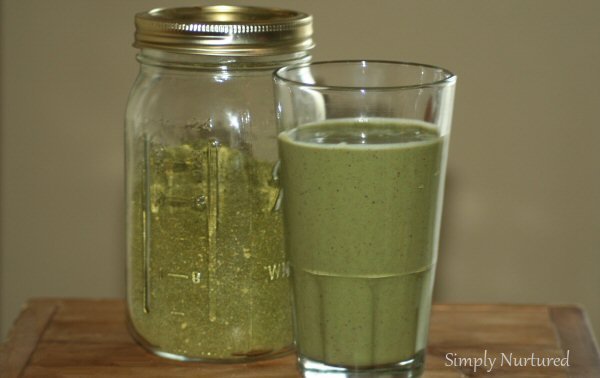
Over time, we’ve learned to gauge how much to add without measuring, so I’m not a great source of smoothie recipe amounts, even though we’ve tried just about everything! We make enough for my older children and I to have about 8 ounces each, while the younger ones (5 and under) get about 4-6 ounces each.
We add about 1/4 -1/3 cup of the herbal mixture to our smoothie batch, which ends up being about one tablespoon each for the older children and myself and about 1/2 tablespoon or so for the little ones. Some days we use more or less or leave it out altogether, depending on the type of smoothie we’re making. Also, it’s not something we take daily, just most of the time.
Interestingly, my youngest children devour their smoothies faster and seem to enjoy them even more than the older ones do. I think it’s because they were accustomed to drinking such a variety of fresh flavor combinations at a much earlier age. Smoothies are a great way to serve fresh fruits and vegetables in a very digestible form to babies and toddlers! Serving them early in the morning gets them off to a great start and ensures they fill up on plenty of essential nutrient-dense foods, which is very important in the early years when their little appetites wax and wane.
I do want to remind you that I am not an expert in nutrition. I’m simply a mom who wants to provide the best foundation of health for my family. I believe the food and herbs God created are the best way to nourish my family, and I am delighted to share with you some of the creative ways I’ve learned to do so! I’d love to hear your input as I know my herbal powder recipe is far from perfect. I’m always learning new ways to keep my family well-nourished and healthy.
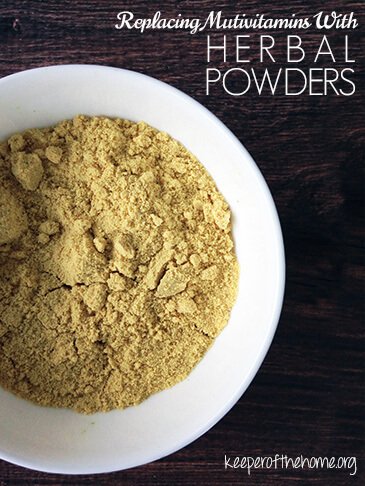


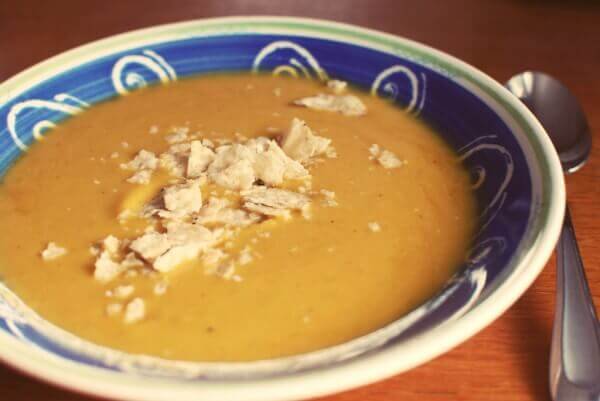
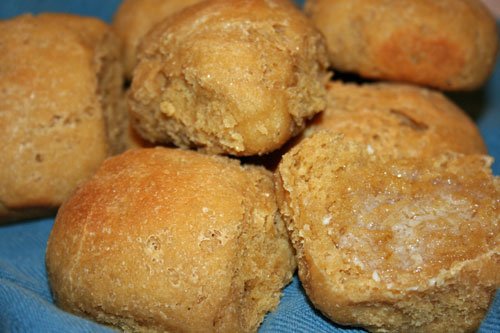

I have never tried an herbal powder formula like the one you described. I did take some herbs when I was receiving acupuncture to treat my infertility. Thanks for posting about this topic… very interesting!
I wonder if a “spiriluna and feta cheese omelette” would be good? 🙂 There are a lot of things on this list missing from my regular diet…although we have done “green smoothies” as a family in the past. Not quite sure what the Mrs. put in there, but there was a spring in my step, for sure. Thanks for the info!! 🙂
“A spring in your step”…:) love it. I know what you mean. Smoothies can be a great start to the day, giving us that needed boost to get going and they can keep us going for a long time! Spiriluna and feta omelet. Hmm, sounds good.
LOVE this idea!! How much of the bulk herbs do you buy at a time?
Some I have on hand because I buy online in larger amounts, usually half a pound, but most I buy from my local health food store/food co-op in the bulk herb section, which all come from Frontier Co-op. When buying locally, I like that I can buy as little or as much as I want, so sometimes it’s only a very small amount. I’m terrible with measuring, so I can’t tell you how much I buy of each. When my mixture gets low, I just sit down and make a list of all herbs I want to add the next time, take into consideration what I have on hand, and then go and buy what I need, just eyeing the amounts…all herbs are added in about the same amounts except for wheatgrass, alfalfa, and spiriluna. I used to buy powder mixes like “Amazing Grass” (I think that was the name), so I remember using those formulas as an initial guide to what to add and how much.
I love herbs and their benifts as well. Where wld one get these herb powders affordably?
Most of my herbs come from Frontier Co-op, the Bulk Herb Store, or Mountain Rose Herbs. (The links to Bulk Herb Store and Mountain Rose are affiliate links.) I’m sure there are other great sources out there. Anyone want to chime in? 🙂 They seem to cost about the same, regardless of the source. Some herbs cost more than others (For instance, dandelion is one of the cheapest. Wheatgrass and spiriluna are more expensive.), but they should cost about the same regardless of where you purchase. the places I mentioned above are of excellent quality, in my opinion.
Are the herbs listed safe for breastfeeding?
I am not an expert, so I can’t tell you with absolute certainty. From my research, I’m comfortable with using the above herbs while breastfeeding. I am currently pregnant and breastfeeding..although my “baby” is almost 2 and we’re working on weaning from the breast. One of my favorite authors on herbs and pregnancy/breastfeeding is Shonda Parker. She has some great books! I use what I find there and compare it to other sources, and vice versa. The thing with herbs is that they’re not regulated like drugs are, so the advice on so many is to avoid while pregnant, so you have to dig deeper to find out for sure. Some herbs listed above can be detoxifying, although in these amounts, I doubt it.
Love this article! We take vitamins that contain whole food nutrients like the greens you mentioned above, and I truly believe that the big dose of vitamin B makes such a difference in my energy levels, especially in the winter. But the price can really add up, and I always struggle with spending so much on something that isn’t even food!
Couple of questions…Do you have any sources for these herbs and powders? And I’d be interested in any tips anyone has for hiding nutrient dense greens and veggies for little ones with small, reluctant appetites.
I can relate to your concerns! And your success with B vitamins. 🙂 I do think there are some great whole foods-based vitamins out there, but they are expensive. With a family of 7, soon to be 8, it can add up. This has proven to be much cheaper for us. (Although we do vitamins at times.)
Frontier Co-op and Bulk Herb Store. Mountain Rose is another one. I get Frontier from my local health food store in the bulk herb section, so I can buy as little or as much as I want. (The links to Bulk Herb Store and Mountain Rose Herbs are affiliate links.)
Fruit is our favorite sweetener/way to cover up the strong green flavor. We also enjoy yogurt smoothies and sometimes add honey. We do like the “garden fresh green taste” in there, but it’s very subtle and the main flavor is the fruit. The smoothie in this picture contains tropical fruit like pineapple, mango, and banana, so while the flavor of these dominates, the color of the greens shines through, making it look like it tastes “veggie green” when it really doesn’t so much. 🙂 When we use berries, our smoothies are usually purple or pinkish because the deep berry colors dominate…same amount of green stuff, though. My little ones love both the purple and the bright green. The littlest ones don’t even mind when it turns out kind of an in between almost brownish color (the clash of green with dark berries), but my older ones are a little turned off my the brownish, as am I. 🙂
Can you or Courtney share a little more about where to find these herbal supplements? I’m a Military Commissary/Costco shopper, and I know next to nothing about where to get green smoothie supplies.
For the herbs, Frontier Co-op (which I buy from my local health food store), Bulk Herb Store, and Mountain Rose Herbs are good sources. I’d check with your local food co-op/health food store on the powdered herbs. If you prefer a pre-mixed formula, I noticed Bulk Herb Store now has one. I used to buy pre-mixed powdered off Amazon, too. (The links to Bulk Herb and Mountain Rose are affiliate links.)
For the smoothie ingredients, just fresh greens and either fresh or frozen fruit. I’ve actually never been to Costco (not one nearby), but I’ve heard they do have some good quality finds for fruits and veggies. I’m sure you can find a lot there.
Such an interesting post! I struggle with supplementing our diet, and have become so extremely overwhelmed with all the options out there, that we just don’t do anything. And the added cost is a huge factor that we can’t afford. But slowly investing in these powders & herbs sounds do-able, and I can add them here & there to our smoothies!
Are all the herbs & powders you listed above safe for pregnancy & nursing? I’m looking for something to supplement my diet after our 4th is born so I am not so fatigued like I was after our 3rd was born. I need to have a clear, easy plan!
Do you steam the kale/spinach before using? Is that necessary?
Thanks, again, so much for this informative post!
Jill
The cost of supplements can get high with a growing family! One reason we’ve turned to herbal powders and smoothies. 🙂 It is very affordable!
I’ve looked into the herbs and feel comfortable using them while pregnant and nursing. (I’m both now.) I’d suggest looking into it yourself, though, since I can’t give you an “expert” answer. Shonda Parker is a great source for herbs during pregnancy and breastfeeding.
Missed your question about the steaming…no, we don’t steam any of our veggies and prefer them raw.
Great post. I sprinkly kelp, dulse granules, and astragulus root powder into the pot whenever I am making rice, soup, casseroles, etc. I don’t measure though.
I, too, put a scoop of some green superfood powder into our smoothies; we have to use blueberries to cover up the green 🙂
Great article. We are moving in this direction too. I always add way more spices and herbs to my cooking than the recipe calls for–almost all have actual nutritional/medicinal values. Except for the pregnant/nursing mom they are very safe (much more so than over-the-counter medicines). Two ways we sneak seaweed into our diet is sprinkling powdered kelp on popcorn and using dulse (another seaweed) in our tea (steep and strain with the tea leaves).
Hi! I love your article! I grew up with my mom giving me “x” name of vitamins and I never felt a difference. I didn’t take any supplements except when I’d get sick. The last three years I discovered an incredible Mulitvitamin that I take 3 times a day. I feel Amazing and very clear-minded! It has no fillers and is from Isolated nutrients from fruits, grains, vegetables and herbs and has no bonding agent so breaks down very quickly in my body. I take additional supplements and powders that contain many of the ones you listed. 🙂 However after reading this I want to add a few to my shakes. I just really need things to taste good. Unfortunately, no matter how good it tastes. I hate the taste of Wheatgrass but I am curious to how Oat Straw tastes. Do you think one could find these at a local farmer’s market? Thank so much! I really appreciate all the info!
I meant to say no matter how good it is for me, if it tastes bad I can’t see myself doing it consistently. Thank you. 🙂
Loved it! just shared the link with lots of friends… Great article.
You mentioned taking an MVI throughout pregnancy and breastfeeding. It’s interesting to note that especially folic acid taken even up to a year prior to pregnancy can prevent poor birth outcomes (neurologic problems and premature birth). Through diet or a supplement, this can be a real benefit for all women who may become pregnant.
Courtney, this is an incredibly informative and helpful post! I feel like we rely too heavily on supplements, but I am in the childbearing-constantly breastfeeding and/or pregnant for the past 4 years, so I do feel like I need them “just in case.” But I am saving this post because I want to try out your suggestions! It sounds much better for our health! Thanks for sharing! Pinning this!
Oh, and I meant to add–my new favorite “green” smoothie: 2-3 Tbsp. peanut butter, 2 Tbsp. cocoa powder, 1 cup milk, 1 cup ice, splash of raw honey, splash of vanilla, and two handfuls of greens. I just started this one yesterday, and I’ve had 3 in 24 hours! It’s more like a dessert–your mention of green smoothies reminded me of it! It’s so yummy–and for those who don’t like greens, there is no hint of greens!
What measurements of each herb to you use to make the mason jar full looking for approx. I started buying a green food supplement that I add into our family shake very pricey I am running out and dreading purchasing another then I was blessed with this awesome blog post and I am interested in starting to make my own. Thank you for this blog and your time.
Jennifer
Thank you so much for this post! I am suffering a host of health issues mostly stemming from weak adrenals. So I need extra nutrients. But I just don’t have peace about spending (aka. wasting) any more $$$ on vitamins and such. After hundreds of dollars spent, I have seen zero improvement in correcting nutritional deficiencies. Not to mention all the nasty additives in pills, capsules, etc. So the idea of getting real whole food nutrition from God-made herbs and such sounds simply wonderful! Went to Whole Foods today and bought some of these items (some were sadly out of stock!). Can’t wait to try them and see how they work!
But I did have ONE QUESTION. Some of my herbs are not powdered (like the oat straw, nettle, and dandelion root. Should I grind these into a powder and take in water or a smoothie? Or should I make teas out of them? Is one way more nutritious than the other, I wonder? Thanks for your help. 🙂
I love the idea of adding this to smoothies. Is there any books that you would recommend on learning more about what herbs are good for what? That would be great!
I would really like to research these more. Do you have any books that you would recommend?
I appreciate your ingeniousness and creativity in finding home made multivitamins and the way to incorporate them in a pleasant way in smoothies. I combined some of my favorite herbs and super-foods (mostly Ayurvedic one) in order to supplement my daily intake of extra vitamins. I like your approach and I encourage you to share more of your ideas.
Thanks.
PS. I prepared a tooth paste fallowing your recipe and I like it very much.